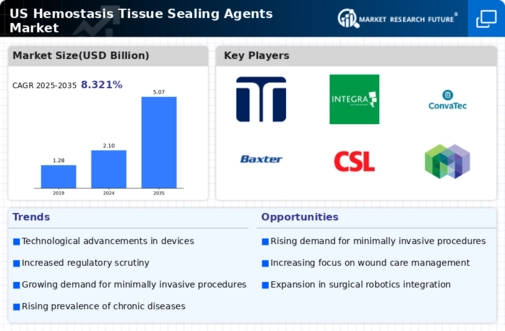Rising Surgical Procedures
The increasing number of surgical procedures in the US is a primary driver for the hemostasis tissue-sealing-agents market. As the population ages and the prevalence of chronic diseases rises, the demand for surgical interventions escalates. According to recent data, the US surgical market is projected to reach approximately $200 billion by 2026, indicating a robust growth trajectory. This surge in surgical activities necessitates effective hemostatic solutions to manage bleeding, thereby propelling the demand for tissue-sealing agents. Furthermore, advancements in minimally invasive surgical techniques are likely to enhance the adoption of these agents, as they are crucial in ensuring patient safety and reducing recovery times. Consequently, the hemostasis tissue-sealing-agents market is expected to benefit significantly from this trend, as healthcare providers seek reliable solutions to improve surgical outcomes.
Increased Focus on Wound Care
The growing emphasis on wound care management is influencing the hemostasis tissue-sealing-agents market. With an increasing incidence of traumatic injuries and surgical wounds, there is a heightened need for effective hemostatic agents that can facilitate rapid wound closure and minimize complications. The US wound care market is anticipated to grow at a CAGR of around 5% over the next few years, reflecting the rising demand for innovative solutions. Hemostasis tissue-sealing agents play a vital role in this context, as they not only promote faster healing but also reduce the risk of infection. As healthcare providers prioritize patient outcomes, the integration of advanced sealing agents into wound care protocols is likely to expand, thereby driving the growth of the hemostasis tissue-sealing-agents market.
Growing Awareness of Patient Safety
The increasing awareness of patient safety is a crucial driver for the hemostasis tissue-sealing-agents market. Healthcare providers are increasingly prioritizing the implementation of strategies that minimize surgical complications and enhance patient outcomes. This focus on safety has led to the adoption of advanced hemostatic agents that can effectively control bleeding during procedures. According to industry reports, the market for patient safety solutions in the US is projected to grow by approximately 8% annually. As hospitals and surgical centers strive to comply with stringent safety regulations, the demand for reliable hemostasis tissue-sealing agents is expected to rise. This trend underscores the importance of integrating effective sealing solutions into surgical practices, thereby fostering growth in the hemostasis tissue-sealing-agents market.
Technological Innovations in Hemostasis
Technological innovations are reshaping the hemostasis tissue-sealing-agents market, as new products and formulations emerge to meet the evolving needs of healthcare professionals. The introduction of bioengineered agents and advanced delivery systems is enhancing the efficacy and safety profiles of these products. For instance, recent advancements in polymer technology have led to the development of novel hemostatic agents that offer superior performance in controlling bleeding. The US market for these innovative solutions is expected to witness substantial growth, with estimates suggesting a potential increase of 10% annually. As hospitals and surgical centers adopt these cutting-edge technologies, the hemostasis tissue-sealing-agents market is likely to experience a significant boost, driven by the demand for improved surgical outcomes and patient safety.
Regulatory Support for Innovative Products
Regulatory support for innovative medical products is significantly impacting the hemostasis tissue-sealing-agents market. The US Food and Drug Administration (FDA) has been actively streamlining the approval process for new hemostatic agents, thereby encouraging the development of advanced solutions. This regulatory environment fosters innovation and allows manufacturers to bring effective products to market more rapidly. As a result, the hemostasis tissue-sealing-agents market is likely to benefit from a diverse range of offerings that cater to various surgical needs. The potential for expedited approvals and favorable reimbursement policies further enhances the attractiveness of this market segment. Consequently, the ongoing regulatory support is expected to drive growth and innovation within the hemostasis tissue-sealing-agents market.





















Leave a Comment